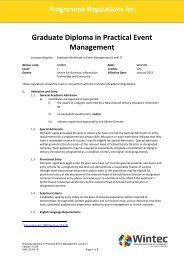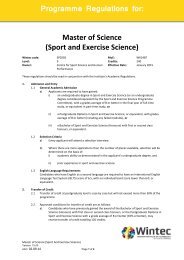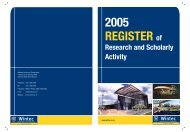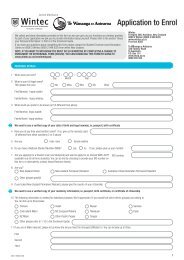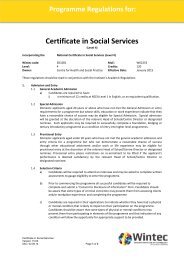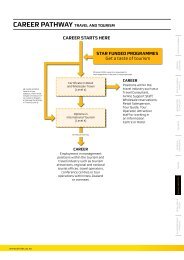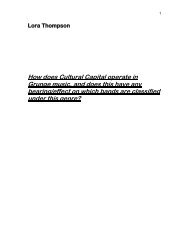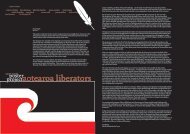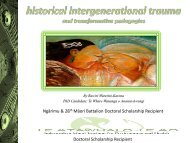Physiological analysis of the metabolic typing diet in professional ...
Physiological analysis of the metabolic typing diet in professional ...
Physiological analysis of the metabolic typing diet in professional ...
Create successful ePaper yourself
Turn your PDF publications into a flip-book with our unique Google optimized e-Paper software.
SMNZ Street Address<br />
NZ Sports Academy SI<br />
40 Logan Park Drive<br />
Duned<strong>in</strong><br />
New Zealand<br />
<strong>the</strong> correct percentages <strong>of</strong> <strong>the</strong> macronutrients.<br />
Carbohydrate types are encouraged to eat accord<strong>in</strong>g<br />
to <strong>the</strong> follow<strong>in</strong>g ratios:<br />
• 15%-20% prote<strong>in</strong> (prote<strong>in</strong>s = meat, fowl,<br />
seafood, dairy)<br />
• 70%-80% carbohydrates (carbohydrates = fruits,<br />
vegetables, gra<strong>in</strong>s)<br />
• 5%-10% oils/natural fats (fats = butter, oils, fatty<br />
foods - exclud<strong>in</strong>g nuts, seeds, cheese, and o<strong>the</strong>r<br />
fatty foods)<br />
Prote<strong>in</strong> types are encouraged to eat accord<strong>in</strong>g to<br />
<strong>the</strong> follow<strong>in</strong>g ratios:<br />
• 45%-50% prote<strong>in</strong> (prote<strong>in</strong>s = meat, fowl,<br />
seafood, dairy)<br />
• 30%-35% carbohydrates (carbohydrates = fruits,<br />
vegetables, gra<strong>in</strong>s)<br />
• 20% oils/natural fats (fats = butter, oils, fatty<br />
foods - exclud<strong>in</strong>g nuts, seeds, cheese, and o<strong>the</strong>r<br />
fatty foods)<br />
Mixed Types are encouraged to eat accord<strong>in</strong>g to <strong>the</strong><br />
follow<strong>in</strong>g ratios:<br />
• 40%-45% prote<strong>in</strong> (prote<strong>in</strong>s = meat, fowl,<br />
seafood, dairy)<br />
• 50%-55% carbohydrates (carbohydrates = fruits,<br />
vegetables, gra<strong>in</strong>s)<br />
• 10%-15% oils/natural fats (fats = butter, oils,<br />
fatty foods - exclud<strong>in</strong>g nuts, seeds, cheese, and<br />
o<strong>the</strong>r fatty foods)<br />
Methods:<br />
Subjects:<br />
Six pr<strong>of</strong>essional rugby players compet<strong>in</strong>g <strong>in</strong> New<br />
Zealand’s prov<strong>in</strong>cial rugby competition, <strong>the</strong> Air New<br />
Zealand Cup, were recruited for this study. Two<br />
subjects were backs (one back withdrew before<br />
completion <strong>of</strong> this study) and four were forwards<br />
(Mean, age = 22 yr, weight = 108.4 kg, height = 187.3<br />
cm, sk<strong>in</strong> folds (sum <strong>of</strong> six) = 89.5 mm). Subjects were<br />
<strong>in</strong>vited to participate depend<strong>in</strong>g on position played<br />
on <strong>the</strong> rugby field and availability to participate.<br />
It was observed that <strong>in</strong> a rugby team body types<br />
could be broken up <strong>in</strong>to three categories: front row,<br />
locks and loose forwards, and backs. Two players<br />
from each group were <strong>in</strong>vited to participate. This<br />
is a broad generalisation but <strong>in</strong> many cases body<br />
types can be dist<strong>in</strong>guished by <strong>the</strong>se groups. Front<br />
rowers are generally more muscular but generally<br />
carry more fat, locks and loose forwards are taller<br />
players who are usually bigger and more muscular<br />
than backs but carry less fat. Backs are generally<br />
<strong>the</strong> leanest and smaller players on <strong>the</strong> team. Each<br />
subject was <strong>in</strong>formed <strong>of</strong> <strong>the</strong> procedures that would<br />
take place and consent was given. All test<strong>in</strong>g was<br />
completed with subjects <strong>in</strong> a fasted state.<br />
Test<strong>in</strong>g was completed on two non-consecutive<br />
days. Day One was used to collect <strong>in</strong>itial results for<br />
basel<strong>in</strong>es and to collect rest<strong>in</strong>g <strong>metabolic</strong> rates. Day<br />
Two was used to adm<strong>in</strong>ister <strong>the</strong> glucose tolerance<br />
test and monitor <strong>the</strong> differences from <strong>the</strong> <strong>in</strong>itial<br />
measures due to <strong>the</strong> glucose tolerance test.<br />
On Day One weight and height were taken, <strong>the</strong>n<br />
<strong>in</strong>formed consent given. Blood pressure was taken<br />
with subjects <strong>in</strong> a seated position us<strong>in</strong>g a standard<br />
sphygmomanometer and stethoscope, rest<strong>in</strong>g heart<br />
was monitored us<strong>in</strong>g a polar heart rate monitor<br />
with subjects ly<strong>in</strong>g down. After <strong>in</strong>itial read<strong>in</strong>gs had<br />
been collected venous blood was taken via f<strong>in</strong>ger<br />
prick. Blood glucose levels and blood pH were<br />
measured us<strong>in</strong>g a multi purpose cartridge. Subjects<br />
<strong>the</strong>n completed <strong>the</strong> MDT questionnaire 7 . The f<strong>in</strong>al<br />
test was <strong>the</strong> Basal Metabolic Rate Test where each<br />
subject lay on <strong>the</strong> bed <strong>in</strong> a comfortable position that<br />
resembled how <strong>the</strong>y normally sleep i.e. on <strong>the</strong>ir front,<br />
back or side. A full face mask was worn and RQ, V e<br />
and V CO2 were measured. With this <strong>in</strong>formation <strong>the</strong><br />
percentage <strong>of</strong> energy derived from each fuel source<br />
could be established and also <strong>the</strong> amount <strong>of</strong> energy<br />
used <strong>in</strong> metabolism could be predicted.<br />
On Day Two subjects were fasted and tested <strong>in</strong><br />
<strong>the</strong> morn<strong>in</strong>g us<strong>in</strong>g <strong>the</strong> same procedure as for<br />
Day One. The ma<strong>in</strong> purpose <strong>of</strong> Day Two’s test<strong>in</strong>g<br />
was to see how each subject reacted dur<strong>in</strong>g <strong>the</strong><br />
glucose tolerance test. Initial data were taken prior<br />
to adm<strong>in</strong>istration <strong>of</strong> glucose/potassium solution,<br />
which <strong>in</strong>cluded BP, HR and blood glucose. The<br />
glucose/potassium solution conta<strong>in</strong>ed 50g <strong>of</strong><br />
glucose and 15g <strong>of</strong> cream <strong>of</strong> tartar (conta<strong>in</strong><strong>in</strong>g 5g<br />
<strong>of</strong> potassium). Adm<strong>in</strong>istration <strong>of</strong> glucose/potassium<br />
solution was given to subjects after pre-test<strong>in</strong>g data<br />
was completed. Subjects’ BP, HR, and blood glucose<br />
were collected at <strong>the</strong> 30 th and 75 th m<strong>in</strong>ute after<br />
adm<strong>in</strong>istration <strong>of</strong> <strong>the</strong> glucose/potassium solution.<br />
A all subjects were seated and comfortable for <strong>the</strong><br />
duration <strong>of</strong> <strong>the</strong> glucose tolerance test.<br />
44 NZJSM



